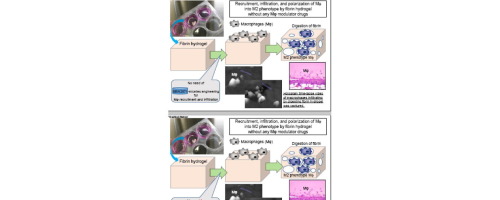当前位置:
X-MOL 学术
›
Acta Biomater.
›
论文详情
Our official English website, www.x-mol.net, welcomes your
feedback! (Note: you will need to create a separate account there.)
Preparation of fibrin hydrogels to promote the recruitment of anti-inflammatory macrophages.
Acta Biomaterialia ( IF 9.4 ) Pub Date : 2019-03-09 , DOI: 10.1016/j.actbio.2019.03.011 Ryusuke Tanaka 1 , Yoichi Saito 2 , Yukio Fujiwara 3 , Jun-Ichiro Jo 1 , Yasuhiko Tabata 1
Acta Biomaterialia ( IF 9.4 ) Pub Date : 2019-03-09 , DOI: 10.1016/j.actbio.2019.03.011 Ryusuke Tanaka 1 , Yoichi Saito 2 , Yukio Fujiwara 3 , Jun-Ichiro Jo 1 , Yasuhiko Tabata 1
Affiliation

|
Macrophages play an important role in regulating inflammation and tissue regeneration. In the present study, uniform fibrin hydrogel scaffolds were engineered in millimeters. These scaffolds induced anti-inflammatory macrophages to digest and infiltrate the scaffold. The culture conditions of the fibrin hydrogels decreased the secretion of tumor necrosis factor-α (TNF-α), a pro-inflammatory cytokine, and increased the secretion of interleukin-10 (IL-10), an anti-inflammatory cytokine, in mouse bone marrow-derived macrophages. Similar results were also observed in human monocyte-derived macrophages (HMDMs). In addition, most of cells that infiltrated the fibrin hydrogels were macrophages expressing CD163, CD204, and CD206, which are anti-inflammatory macrophages markers, both in mice and in human cells. Therefore, to induce increased macrophage infiltration, we attempted to combine fibrin hydrogels with SEW2871, a monocyte/macrophage recruitment agent that is known to be a sphingosine-1 phosphate receptor 1 agonist, solubilized in water by micelle formation with a cholesterol-grafted gelatin. However, the fibrin hydrogels alone retained the same monocyte migration activity as the hydrogels with SEW2871-incorporated micelles in the hydrogel-bearing mouse model. These findings indicate that fibrin hydrogels have a strong promoting effect on the recruitment of anti-inflammatory macrophages. Therefore, fibrin hydrogels may be an optimal biomaterial in the design of medicines for macrophage-induced regenerative therapies. STATEMENT OF SIGNIFICANCE: The immune response to tissue injury is important for determining the speed and the result of the regeneration. Alternatively activated macrophages (M2 macrophages) resolve inflammatory response and promote tissue repair by producing anti-inflammatory factors. Promoting the recruitment of macrophages is a hopeful strategy in the design of biomaterials for tissue regeneration. In the present study, we combined the fibrin hydrogel, which promotes anti-inflammatory polarization, with a macrophage recruitment agent. We revealed that the fibrin hydrogel significantly promoted anti-inflammatory polarization in mouse in vivo and human in vitro. Moreover, macrophages significantly infiltrated into the fibrin hydrogel regardless of the agent combination. Fibrin hydrogels may become a reliable biomaterial for tissue regeneration, and the present study is believed to provide information for many researchers.
中文翻译:

制备纤维蛋白水凝胶以促进抗炎巨噬细胞的募集。
巨噬细胞在调节炎症和组织再生中起重要作用。在本研究中,以毫米为单位设计了均匀的纤维蛋白水凝胶支架。这些支架诱导抗炎巨噬细胞消化并渗透到支架中。纤维蛋白水凝胶的培养条件降低了小鼠促炎细胞因子肿瘤坏死因子-α(TNF-α)的分泌,并增加了小鼠抗炎细胞因子白细胞介素10(IL-10)的分泌。骨髓来源的巨噬细胞。在人单核细胞衍生的巨噬细胞(HMDM)中也观察到了相似的结果。此外,大多数渗透到纤维蛋白水凝胶的细胞都是在小鼠和人类细胞中表达CD163,CD204和CD206的巨噬细胞,它们是抗炎性巨噬细胞标记。所以,为了诱导巨噬细胞浸润增加,我们尝试将纤维蛋白水凝胶与SEW2871(一种单核细胞/巨噬细胞募集剂,已知为Sphingosine-1磷酸受体1激动剂)组合,通过与胆固醇接枝的明胶形成胶束而溶于水。但是,在带有水凝胶的小鼠模型中,单独的纤维蛋白水凝胶保留了与带有SEW2871的胶束的水凝胶相同的单核细胞迁移活性。这些发现表明纤维蛋白水凝胶对抗炎巨噬细胞的募集具有强烈的促进作用。因此,纤维蛋白水凝胶可能是巨噬细胞诱导的再生治疗药物设计中的最佳生物材料。意义声明:对组织损伤的免疫反应对于确定再生的速度和结果很重要。或者,活化的巨噬细胞(M2巨噬细胞)通过产生抗炎因子来解决炎性反应并促进组织修复。促进巨噬细胞的募集是用于组织再生的生物材料设计中的一种有希望的策略。在本研究中,我们将促进抗炎性极化的纤维蛋白水凝胶与巨噬细胞募集剂相结合。我们揭示了纤维蛋白水凝胶在小鼠体内和人类体外显着促进了抗炎极化作用。而且,无论试剂组合如何,巨噬细胞都显着渗透到纤维蛋白水凝胶中。纤维蛋白水凝胶可能成为一种可靠的组织再生生物材料,目前的研究被认为为许多研究人员提供了信息。
更新日期:2019-03-09
中文翻译:

制备纤维蛋白水凝胶以促进抗炎巨噬细胞的募集。
巨噬细胞在调节炎症和组织再生中起重要作用。在本研究中,以毫米为单位设计了均匀的纤维蛋白水凝胶支架。这些支架诱导抗炎巨噬细胞消化并渗透到支架中。纤维蛋白水凝胶的培养条件降低了小鼠促炎细胞因子肿瘤坏死因子-α(TNF-α)的分泌,并增加了小鼠抗炎细胞因子白细胞介素10(IL-10)的分泌。骨髓来源的巨噬细胞。在人单核细胞衍生的巨噬细胞(HMDM)中也观察到了相似的结果。此外,大多数渗透到纤维蛋白水凝胶的细胞都是在小鼠和人类细胞中表达CD163,CD204和CD206的巨噬细胞,它们是抗炎性巨噬细胞标记。所以,为了诱导巨噬细胞浸润增加,我们尝试将纤维蛋白水凝胶与SEW2871(一种单核细胞/巨噬细胞募集剂,已知为Sphingosine-1磷酸受体1激动剂)组合,通过与胆固醇接枝的明胶形成胶束而溶于水。但是,在带有水凝胶的小鼠模型中,单独的纤维蛋白水凝胶保留了与带有SEW2871的胶束的水凝胶相同的单核细胞迁移活性。这些发现表明纤维蛋白水凝胶对抗炎巨噬细胞的募集具有强烈的促进作用。因此,纤维蛋白水凝胶可能是巨噬细胞诱导的再生治疗药物设计中的最佳生物材料。意义声明:对组织损伤的免疫反应对于确定再生的速度和结果很重要。或者,活化的巨噬细胞(M2巨噬细胞)通过产生抗炎因子来解决炎性反应并促进组织修复。促进巨噬细胞的募集是用于组织再生的生物材料设计中的一种有希望的策略。在本研究中,我们将促进抗炎性极化的纤维蛋白水凝胶与巨噬细胞募集剂相结合。我们揭示了纤维蛋白水凝胶在小鼠体内和人类体外显着促进了抗炎极化作用。而且,无论试剂组合如何,巨噬细胞都显着渗透到纤维蛋白水凝胶中。纤维蛋白水凝胶可能成为一种可靠的组织再生生物材料,目前的研究被认为为许多研究人员提供了信息。































 京公网安备 11010802027423号
京公网安备 11010802027423号